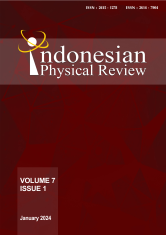STUDY OF VOLTAGE AND ELECTRIC CURRENT GENERATED FROM CU-ZN ELECTRODES IN A MEDIUM OF SAWDUST AND COAL STOCKPILE WASTEWATER.
DOI:
10.29303/ipr.v7i1.245Downloads
Abstract
Industrialization has positive effects on the economy, but on the other hand, it also adversely impacts the environment and energy needs. This phenomenon needs to be solved in an integrated way, including using wastewater from coal stocks and sawdust as electrolyte media to generate electrical energy. This study aims to analyze the voltage and electric current generated by electrode pairs consisting of copper (Cu) and zinc (Zn) immersed in different sawdust media denoted as M1 (2 grams), M2 (4 grams), M3 (6 grams), and M4 (8 grams), dissolved in 100 milliliters of coal stockpile wastewater. Additionally, the study explores the effects of varying the distance between the Cu-Zn electrodes at 1, 2, and 3 cm. The results showed that the highest voltage generated from the combination of coal stockpile wastewater and sawdust was highest in M3 (6 grams of sawdust + 100 ml of coal stockpile wastewater at a distance of 1 cm at 0.736 volts. The highest electrical current generated by the Cu-Zn electrode in the M3 media combination was 0.221 mA. It is due to coal stockpile wastewater in M3 sawdust powder, which contains ions that enhance electron conduction compared to M4.
Keywords:
coal stockpile wastewater sawdust Cu and Zn electrodes voltage electric currentReferences
Setiawan, D. Budianta, Suheryanto, and D. P. Priadi, “Contents of Heavy Metal in Soil and Water at Stockpile Coal (Case Study Kertapati Palembang City Indonesian),†Pollut. Res., vol. 37, no. 2, pp. 301–306, 2018.
A. A. Setiawan, D. Budianta, Suheryanto, and D. P. Priadi, "Review : Pollution due to Coal Mining Activity and its Impact on Environment," Sriwij. J. Environ., vol. 3, no. November 2017, pp. 1–5, 2018, doi: 10.22135/sje.2018.3.1.1-5.
A. A. Setiawan, P. Lumban, E. Novaldo, and P. L. Toruan, “Pemanfaatan Elektroda Karbon Dan Aluminium Untuk Menurunkan Ion-Ion Terlarut Limbah Stockpile Batubara,†Redoks, vol. 6, no. 2, pp. 38–47, 2021.
A. A. Setiawan and R. Fitriyant, "The Utilization of Carbon Electrodes to Reduce Dissolved Ions from Coal Stockpile Wastewater," Sriwij. J. Environ., vol. 6, no. 3, pp. 107–113, 2022.
A. Saleh, I. Novianty, S. Murni, and A. Nurrahma, “Analisis Kualitas Briket Serbuk Gergaji Kayu Dengan Penambahan Tempurung Kelapa Sebagai Bahan Bakar Alternatif,†Al-Kimia, vol. 5, no. 1, pp. 21–30, 2017.
Setiawan, A. Arinafril, and K. A. Hanafiah, “Efektifitas Kulit Kacang Tanah, Sekam Padi dan Serbuk Gergaji Sebagai Bioadsorben dalam Menyerap Ion Pb2+,†Sainmatika, vol. 9, no. 1, pp. 1–7, 2012.
D. Intan, I. Said, and P. H. Abram, “Pemanfaatan Biomassa Serbuk Gergaji Sebagai Penyerap Logam Timbal The Utilization of Sawdust Biomass as Adsorbent for Lead Metal,†Akad. Kim, vol. 5, no. 4, pp. 166–171, 2016.
S. Komarayati, “Pemanfaatan Serbuk Geraji Limbah Industri Kompos (The Utilization of Industrial Waste Sawdust as Compost ),†Bul. Penelit. Has. Hutan, vol. 14, no. 9, pp. 337–343, 1996.
D. Ernawati, M. Arifudin, and S. B. Husodo, "Baterai Ramah Lingkungan dari Limbah Serbuk Kayu Merbau ( Intsia bijuga ) dan Matoa ( Pometia sp .) ( Eco-friendly battery from Merbau ( Intsia bijuga ) and Matoa ( Pometia sp .) sawdust )," Ilmu Teknl. Kayu Trop., vol. 17, no. 1, pp. 83–89, 2019.
G. A. Pauzi et al., "Improvement of Electrical Characteristics of Electrochemical Cells made from Sea Water Using Electroplating Method of Cu (Ag)-Zn Electrode as Renewable Energy Source," J. Phys. Conf. Ser., vol. 1338, no. 1, 2019, doi: 10.1088/1742-6596/1338/1/012017.
A. Susanto, M. S. Baskoro, S. H. Wisudo, and M. Riyanto, "Performance of Zn-Cu and Al-Cu Electrodes in Seawater Battery at Different Distance and Surface Area," vol. 7, no. 1, 2017.
R. Setiawan, S. Eddy, and A. Arif Setiawan, “Pemanfaatan Logam Tembaga dan Seng Sebagai Sel Volta Dalam Media Limbah Buah-Buahan.,†J. Penelit. Fis. dan Ter., vol. 5, no. 1, pp. 1–9, 2023, doi: 10.31851/jupiter.v5i1.9128.
N. Pulungan, M. A. Febria, I. Desma, R. D. Ayuningsih, and Y. Nila, “Pembuatan Bio Baterai Berbahan Dasar Kulit Pisang,†Hasanuddin Student J., vol. 1, no. 2, pp. 96–101, 2017.
F. Salafa, L. Hayat, and A. Ma'aruf, "An_Analysis_of_Orange_Peel_Citrus_Sinens," Ris. Rekayasa Elektro, vol. 2, no. 1, pp. 1–9, 2020.
K. A. Khan, "Development of a new theory for PKL electricity using Zn / Cu electrodes : per pair per volt Development of a new theory for PKL electricity using Zn / Cu electrodes : per pair per volt," Int. J. Adv. Res. Innov. Ideas ducation, vol. 5, no. 3, pp. 2394–4396, 2019.
A. Golberg, H. D. Rabinowitch, and B. Rubinsky, "Zn / Cu-vegetative batteries , bioelectrical characterizations , and primary cost analyses Zn / Cu-vegetative batteries , bioelectrical characterizations , 2 and primary cost analyses," J. Renew. Sustain. Energy, vol. 2, no. 1, pp. 1–12, 2010, doi: 10.1063/1.3427222.
. U. Z. S., "the Future of Energy Bio Battery," Int. J. Res. Eng. Technol., vol. 02, no. 11, pp. 99–111, 2013, doi: 10.15623/ijret.2013.0211017.
Y. O. Ansanay, A. Walilo, and O. Togibasa, "Novelty potential of utilizing local betel nut (Areca catechu) of Papua as a bio-battery to produce electricity," Int. J. Renew. Energy Res., vol. 9, no. 2, pp. 667–672, 2019, doi: 10.20508/ijrer.v9i2.8666.g7636.
J. B. Goodenough and K. Park, "The Li-Ion Rechargeable Battery: A Perspective," J. Am. Chem. Soc., vol. 135, p. 1167, 2012.
D. Chao et al., "An Electrolytic Zn–MnO 2 Battery for Highâ€Voltage and Scalable Energy Storage ," Angew. Chemie, vol. 131, no. 23, pp. 7905–7910, 2019, doi: 10.1002/ange.201904174.
A. Yoffi, “Kajian Limbah Buah Dan Sayur Dengan Ilmu Agroteknologi Sebagai Energi Alternatif Bio Baterai,†in Seminar of Social Sciences Engineering & Humaniora, 2020, pp. 1–8.
I. Pawarangan, M. Pineng, and S. A. Anum, "The electrical productivity of Arabica coffee grounds battery based on electrode distance and dryness level," J. Ris. dan Kaji. Pendidik. Fis., vol. 9, no. 1, pp. 1–8, 2022, doi: 10.12928/jrkpf.v9i1.20.
License

This work is licensed under a Creative Commons Attribution-NonCommercial-ShareAlike 4.0 International License.
Authors who publish with Indonesian Physical Review Journal, agree to the following terms:
- Authors retain copyright and grant the journal right of first publication with the work simultaneously licensed under a Creative Commons Attribution-ShareAlike 4.0 International Licence (CC BY SA-4.0). This license allows authors to use all articles, data sets, graphics, and appendices in data mining applications, search engines, web sites, blogs, and other platforms by providing an appropriate reference. The journal allows the author(s) to hold the copyright without restrictions and will retain publishing rights without restrictions.
- Authors are able to enter into separate, additional contractual arrangements for the non-exclusive distribution of the journal's published version of the work (e.g., post it to an institutional repository or publish it in a book), with an acknowledgment of its initial publication in Indonesian Physical Review Journal.
- Authors are permitted and encouraged to post their work online (e.g., in institutional repositories or on their website) prior to and during the submission process, as it can lead to productive exchanges, as well as earlier and greater citation of published work (See The Effect of Open Access).





